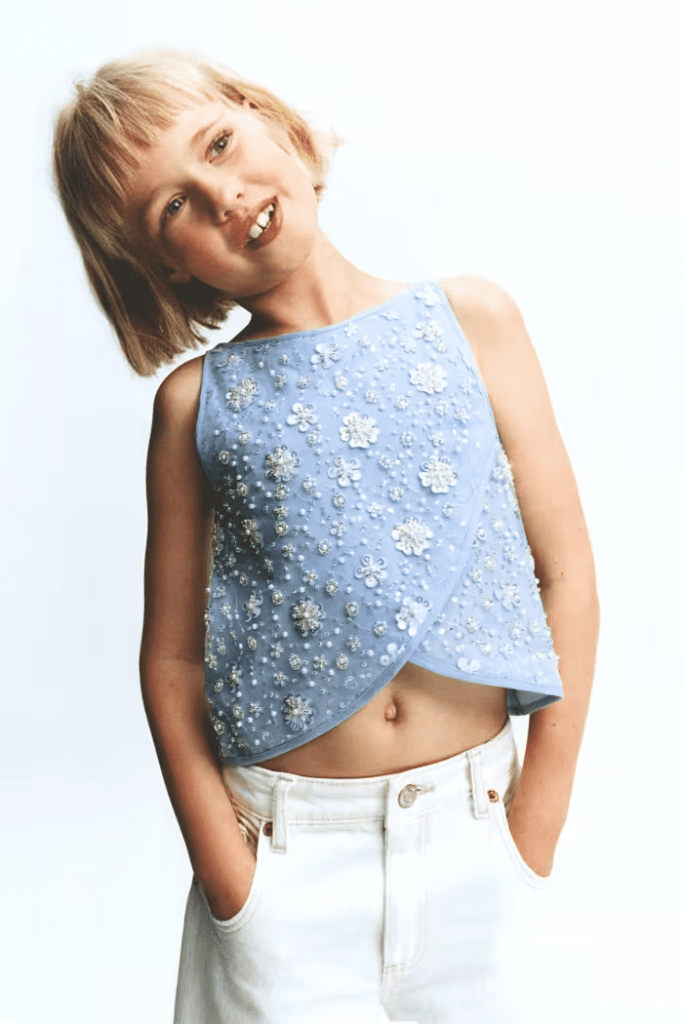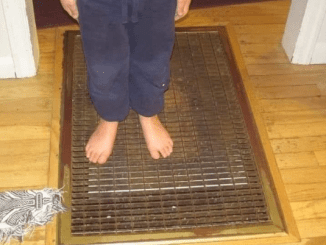The topic of children’s fashion, especially when it comes to young girls under 12 wearing crop tops, sparks intense discussions among parents, guardians, and society as a whole. Should little girls be encouraged to wear clothing that resembles adult fashion, or is it important to preserve their innocence and ensure age-appropriate attire? In this article, we’ll look at some of the reasons many believe young girls shouldn’t wear crop tops, considering aspects of childhood development, societal influences, and the role of parenting in these decisions.

Understanding Childhood and Development
Young children are in a crucial phase of growth and discovery, and their clothing can impact their experience of childhood. Fashion choices can influence how they see themselves and how others perceive them, which is why clothing is more than just fabric—it’s a part of childhood identity.
Preserving Innocence and Joy of Childhood
One key reason parents hesitate to allow their daughters to wear crop tops is the desire to protect the innocence of childhood. Crop tops are often associated with teenage and adult fashion trends, which may introduce young girls to styles they don’t fully understand. Childhood is a short and precious time meant for play, exploration, and joy—elements that don’t need to be shaped by adult-like fashion.
Parents who choose not to let their young daughters wear crop tops often do so out of a desire to keep the focus on being a child, not on the pressures of fashion or appearance. This preservation of innocence allows kids to just be kids, free from societal expectations tied to appearance.
Supporting Positive Self-Esteem and Body Image
What children wear can affect their developing sense of self. Age-appropriate clothing that respects their developmental stage can help young girls foster a positive body image and self-esteem. In contrast, styles that mirror adult fashion might inadvertently shift focus toward how they look, which may lead to self-consciousness at an age when they should be carefree.
By encouraging young girls to wear clothes that are comfortable and designed for their age, parents can help them feel secure and happy in their own skin. Age-appropriate attire can be empowering, allowing girls to focus on their personalities, skills, and friendships, rather than how they appear.
The Influence of Social Pressure on Young Girls
Today’s children are growing up in a world dominated by social media and images that often set unrealistic standards. Clothing can amplify this pressure, making kids feel the need to conform to trends before they’re emotionally ready to understand them.
Shielding Children from Early Social Pressures
Children may be introduced to social pressures regarding appearance and style much earlier than previous generations. Crop tops, for example, can make young girls feel like they need to “fit in” or dress like older children. This early exposure can be stressful, encouraging young girls to judge themselves based on their appearance or others’ perceptions.
Parents who choose not to allow crop tops are often motivated by a desire to protect their children from feeling pressured to meet certain fashion expectations too soon. Allowing children to dress in simple, playful clothing can give them more time to develop a healthy self-image, free from the outside pressures of style and conformity.

Modesty and the Importance of Setting Boundaries
Modesty is a value some parents wish to instill in their children, and clothing is one way to teach boundaries and respect. For many, crop tops don’t align with the lessons they want to pass down, particularly about self-respect and body confidence.
Teaching Boundaries Through Age-Appropriate Clothing
Clothing can be a powerful tool in helping young girls understand boundaries. Teaching them to dress in a way that respects their age can support the idea that they’re in control of their bodies and can choose how they present themselves. Wearing clothes that cover the body more fully can also subtly reinforce the concept of personal space and self-respect.
Parents who view modest clothing as a positive influence see it as a way to help their daughters develop a balanced understanding of fashion that respects their body while also understanding the importance of setting boundaries.
Reducing Unwanted Attention and Protecting Children
Parents may also have safety concerns about crop tops drawing unnecessary or unwanted attention toward young girls. Kids are naturally curious and carefree, so making sure they’re dressed in a way that doesn’t attract undue interest or attention helps create a safe, child-friendly environment for them to grow and play in.
Considering Cultural and Family Values
Every family has unique values and cultural perspectives on what clothing is suitable for children. In many cultures, clothing is not merely a personal choice but a way to respect traditions, family values, and societal expectations.
Respecting Cultural Norms and Diverse Perspectives
In some cultures, modest clothing is a part of everyday life, and dressing children in certain ways reflects these deeply held beliefs. For families with these values, crop tops might feel inappropriate, not just for the child’s age, but also in the context of cultural respect.
Parents who uphold these values may feel that avoiding crop tops aligns with the lessons they want to teach their children, and it’s a way of honoring the family’s heritage and perspectives on clothing.

The Role of Parenting in Making Fashion Choices
Ultimately, the decision about whether young girls wear crop tops falls to parents and guardians. The role of parents extends beyond simply saying “yes” or “no” to clothing choices; it’s about guiding children in making thoughtful, age-appropriate decisions.
Providing Guidance and Setting Positive Examples
Parents are role models, and their guidance on clothing reflects broader values about self-respect, self-image, and societal expectations. By encouraging their daughters to make choices aligned with these values, parents can help instill a sense of personal responsibility and respect.
Creating Opportunities for Important Conversations
Fashion can serve as a gateway to meaningful conversations about self-respect, confidence, and individuality. Parents who thoughtfully explain their reasons for encouraging or discouraging certain clothing items, like crop tops, open doors to larger discussions about how to navigate personal expression within the framework of family values.
Conclusion: Embracing Childhood While Balancing Fashion Choices
In today’s world, where children are exposed to trends at a young age, it’s natural for parents to question the appropriateness of certain clothing, like crop tops, for young girls. The desire to preserve innocence, protect self-esteem, and respect family and cultural values all play a role in shaping these decisions.
Ultimately, the choice of whether or not young girls should wear crop tops is deeply personal and varies from family to family. What’s most important is that children feel secure, supported, and allowed to experience childhood without unnecessary pressures. For many parents, this means choosing age-appropriate clothing that lets young girls express themselves while preserving the joy, innocence, and safety of their formative years.


